104 E. Ocean Blvd. Long Beach, CA 90802 | map |
Opened: December 19, 1920 as
Loew's State Theatre with Metro's "The Mutiny of the Elsinore" as the initial film. It was in the Markwell Building, later renamed the Jergins Trust Building, located on the southeast corner of Ocean Blvd. and Pine Ave. This wonderful 1931 photo by C.C. Pierce is in the
California State Library
collection, their item #01377833. The marquee advises that this was the
last day to see Marilyn Miller in "Sunny," a November 1930 release. A
copy of the photo is also on the
USC Digital Library website.
The State was the major film and vaudeville house in Long Beach until
the West Coast came along in 1925 to share the spotlight. In "New Loew Theatre Ready For Patrons At Noon Of Sunday," a December 18 article in
the Long Beach Daily Telegram, they noted that the circuit at that time included 103 houses. On the west coast they had
theatres in San Francisco, Los Angeles, Salt Lake City, Fresno,
Stockton, Everett and Sacramento. Loew was only involved with the State for several years. After he left it was just advertised as the State Theatre.
Architects: Harvey H. Lochridge and Kirkland Cutter designed the building and the theatre inside. It started as a four story building and later got an addition that was designed by Lochridge. Plans for the building had been announced as early as August 1916. Construction began and then was halted after the framing was up due wartime materials shortages. Ron Mahan notes that it was referred to as the Markwell Theatre in early reports of the construction.
Seating: 1,800
An ad in the Long Beach Press on December 18. It's from the Ronald W. Mahan Collection.
The Long Beach Press reported on the opening in a December 20, 1920 article. Thanks to the Ronald W. Mahan Collection for sharing the text:
"LOEW'S STATE THEATER IS PACKED FOR OPENING - Loew's State theatre, one of the handsomest show houses on the Pacific coast, informally opened its doors at 12:30 p.m. yeaterday for its initial performance. The opening drew one of the largest crowds ever attending a performance of any kind in the city. The opening was thirty minutes late due to some final touches being given to stage electrical devices and lighting effects. For two hours prior to opening the doors a line-up of people eager to be admitted to the new playhouse's first performance extended for almost a block. Crowds continued to come all afternoon, taking the house capacity to overflowing with a waiting assemblage of several hundred. From the time the show started every one of the 1800 seats was occupied and it is estimated that over ten thousand people were admitted to the theatre during the day.
"The interior of Loew's is beautiful. Perhaps the most significant attraction is the large, spacious foyer on the second floor, which Manager Lester J. Fountain, resident manager for Ackerman & Harris, Pacific Coast managers for the Marcus Loew chain of theatres, has set aside for the convenience of his patrons. Here in a space 24 by 30 feet, are luxuriously upholstered divans and chairs. It is called the waiting room and those who so desire may meet their friends there before going into the show. The ladies restroom adjoining the waiting room is an example of elegance and comfort. A telephone, writing table and many other features are provided. An Old English smoking room, with leather upholstered chairs, is also provided for men. An Italian renaissance painting which required three months to complete adorns the dome of the theatre. Luxurious polychrome decorative color effects are evident in every direction.
"The balconies are approached by two wide, circular stiarcases from the north and south ends of the first floor foyer. They are carpeted with rich, velvety material. Seats throughout the theatre are on a sharp incline from the orchestra pit backward. There is one loge box in the theatre and it has elegantly upholstered chairs in blue velvet. These seats, twelve in all, are the only ones not obtainable for the general admission price. They are not reserved but may be had by anyone when not occupied. A pipe organ of rare tonal qualities, besides an orchestra of several pieces, furnishes a variety of musical numbers. The ushers, young men on the first floor, with girls attending the balconies are dressed in costumes which have a trace of Spanish to their design and which blend with the decorative effects.
"Sam Harris of San Francisco, head of the Ackerman & Harris theatres in California, was present at the opening yesterday. He was elated with the big ovation Long Beach people gave the opening of the house here. According to Mr. Fountain, Mr. Harris has been in the theatrical business on the coast for the past quarter century and he says Mr. Harris can be depended upon to give the best entertainment obtainable in their new theatre here. Mr. Fountain was likewise highly gratified with the splendid response on the opening day.
"The house personnel of the new Long Beach theatre is Lester J. Fountain, manager; Frank E. Young, assistant manager; Donald G. Sibert, assistant manager; Dr. J. Nelson Barnes, house physician; John McDermott, chief of ushers; Vincent Snider, doorman; R.E. Stevens, footman; Miss Goldie Hackney, treasures; Miss Marjorie Goddard, cashier; Miss Katherine Burns, matron; S. Campton Campbell, orchestra director; P.E. Felton, organist; M.E. Taylor, stage manager. The program consists of five acts of vaudeville, and two movies, in addition to news films. It is changed twice weekly."
The article in the Press misspoke about "two movies" as the format for the film portion of the programs was only a single feature plus a newsreel. And despite what the article might have you believe, the State was a house with a single balcony. The theatre is listed as Loew's State in the 1920 and 1921 city directories, but not later. Lester J. Fountain was listed as manager in those two directories.
An ad in the Long Beach Press for the theatre's inaugural program that appeared on December 20, the day after the opening. Thanks to the Ronald W. Mahan Collection for sharing the ad.
A December 22, 1920 as in the Daily Telegram that looks like it was designed by an aspiring architect. This was the theatre's second program. They were running split weeks. The ad is from the Ronald W. Mahan Collection.
"Meet your friends before the show in the luxurious rest rooms at Loew's." This ad for the theatre's second program appeared in the December 23, 1920 issue of the Long Beach Daily Telegram. It's from the the Ronald W. Mahan Collection.
"Get the Loew Twice-a-Week Habit!" It's a May 1921 ad for "The Daughter Pays" that was located by Ken McIntyre. Plus you got five acts of Loew's vaudeville: "Every One Refreshing as a Sea Breeze."
In 1922 Loew's participated in the "First Annual Go To Theatre Week." See the
February 11 Daily Telegram ad announcing that event that encouraged patrons to "Go At Least Three
Times!."
A February 26, 1922 ad that appeared in the Long Beach Daily Telegram. Thanks to the Ronald W. Mahan Collection for the ad. It appears they were still using the Loew's name for a period after Marcus Loew ended his involvement with the operation.
A
1923 ad for the State Theatre, listed along with
other "Leading Theatres of Long Beach," in the Yearbook for the station
employees of the Union Pacific Railroad. Thanks to Michelle Gerdes for finding the
book on eBay. The State is listed as being operated by Ackerman & Harris.
That San Francisco-based firm was the "Western Representative" for Marcus Loew. It appears that they stuck around to run the State even after Loew pulled the plug on his involvement. Until 1925 A&H also ran
Loew's State in downtown Los Angeles and
Loew's Warfield in San Francisco for Loew. They're listed as operators of the State in the 1922 Long Beach city directory.
Evidently it was sometime in 1923 that the theatre was taken over by William J. Fahey and his partner W. J. Johnson. They're listed as the proprietors in the 1923 city directory. Fahey had earlier operated the
Theatorium, then went on to the
Joyland, and in 1916 opened the
Palace Theatre. Johnson at some point dropped out of the operation.
One oft-repeated story is that Fahey sold his theatres in 1950 but it's
unknown what his holdings were at that point. He certainly wasn't at the
State anymore as after the mid-30s it was being operated by Cabart Theatres. Ken McIntyre found a May 1985 L.A. Times article interviewing William Fahey's son Harold who noted that his father often said he "made a million dollars" off the State. The article is reproduced at the bottom of the page.
An ad that appeared in the Long Beach Daily telegram on April 27, 1924. Thanks to the Ronald W. Mahan Collection for sharing it.
In 1926 the building was purchased by the Jergins Oil Co. Three
additional stories and a penthouse designed by Lochridge were added to
the building in 1929. Until a new courts building was completed in 1960, this building also housed the Long Beach Municipal Court. The basement of the building was an underground shopping arcade that
opened onto the beach on the south end and also connected to a 35' wide
pedestrian subway heading north under Ocean Blvd.
The State escaped the 1933 Long Beach earthquake relatively unscathed. Thanks to Scott Pitzer for locating this item that appeared in the Long Beach Press-Telegram. Things were more dire down at the Imperial where the facade and marquee collapsed, killing an assistant manager.
By 1936 the house was being operated by Milt Arthur's Cabart Theatres. It's mentioned in various news stories about the opening of their new
Cabart Theatre on Anaheim St. that year. At the time they were getting ready to open the the
Rivoli on American Ave. and would later add the
Towne and others.
The State running day-and-date with two other Cabart houses for "Station West" in 1948. Thanks to Scott Pitzer for locating the ad.
We don't really get a good idea how the theatre was situated in the building in this detail from image 29 of the 1950 Sanborn Fire Insurance Map that's in the
Library of Congress collection. But they do tell us that the theatre extended up to the 3rd floor. And note the "Stage & Scenery" notation on the right indicating that the stage was on the east side of the building.
A
December 31, 1950 ad in the L.A. Times for the State and other
theatres in the Cabart circuit. Thanks to Ken McIntyre for locating it.
A grand reopening with a new family policy after a dark period. Thanks to Ken McIntyre for locating this January 5, 1977 ad. The last major circuit to operate the theatre was Pacific Theatres.
Filipino movies in June 1977. With that wide black border this ad located by Ken McIntyre looks like a death announcement.
Closing: The State closed in September 1977.
Status: It was demolished in June 1988 for a big condominium project that was never completed.
Interior views:
More exterior views:
1913 - Part of the vacant lot where the Markwell building would be constructed. We're looking north toward Ocean Blvd. with Pine Ave. on the left. It's a photo from the Ronald W. Mahan Collection. The side of the
Coughran Opera House is visible up on 1st St.
1916 - Framing going up for the State, behind the Municipal Auditorium. The work was halted due to wartime materials shortages. It's a photo from the Ronald W. Mahan Collection. Thanks, Ron.
1916 - A detail from the previous Mahan Collection image.
c.1917 - A construction view from the water. Thanks to Michelle Gerdes for finding this lovely shot on eBay.
1917 - A July 4 photo looking east from the pier that was taken by J. Heitzenrider. The Markwell's framing is on the left with the
Municipal Auditorium on the right. The photo is in the collection of the
Long Beach Public Library.
c.1920 - The theatre as Loew's State. Note, in addition to the Loew's roof signs (and "Loew's State" on the marquee), there's a roof sign for the "Palais de Danse" with a "Dancing" sign above the entrance to the right of the theatre's marquee. The walkway in the center leading to the basement level has signage saying "To Beach" and "Arcade Shops." It's a photo in the
Long Beach Public Library collection from W.J. and Harold Fahey via M.R. Krythe. A copy is also in the
Los Angeles Public Library collection.
c.1921
- A strange postcard showing the theatre with the marquee deleted. Note
the "Loew's" appearing on the roof sign. The card is from the
collection of Michelle Gerdes. Also from Michelle are her
Long Beach photo album and a fine
California Theatres set, both on Flickr.
c.1921
- A beach view toward Loew's State. On the left we get a view of the back of the
Theatorium stagehouse,
halfway up the card. The card is from the
Long Beach Heritage Museum collection.
c.1922 - Marcus Loew has left town and the marquee has been redone to just say "State" in the middle. That's the staff out in front. "Exit the Vamp" was a November 1921 release. It's a Winstead photo in the
Los Angeles Public Library collection.
c.1923 - The State's on the far right in this snapshot Michelle Gerdes spotted on eBay. Note the "Loew's" letters had been taken off the roof sign and "State" hadn't yet been centered. We're seeing the back of the sign that faced Ocean Blvd.
c.1924 - The State is on the far right in this photo from the California Historical Society that appears on the
USC Digital Library website. A bit later and we'd see the West Coast rising in the distance.
1925
- An interesting look behind the stagehouse of Hoyt's, later renamed the
Strand. Beyond, we get
the State Theatre building and, to the right, the 1905 Municipal
Auditorium. Down Ocean Blvd. in the distance the
West Coast Theatre is being constructed. At the far left is the Heartwell Building, also under construction. The photo is in the
Los Angeles Public Library collection.
1925 - A panorama by Pettit's Studio looking west
along Ocean Blvd. At the left side of the image there's a view of the Municipal Auditorium, the back of the Ritz (later the Capitol, then the
Tracy),
and the State Theatre. The
West Coast is in the center of the image with the stagehouse of the Mission/Fox Long Beach just behind. It's a photo in the
Huntington Library collection. Someone put a 1924 date on the image but that's a bit too early for it.
1925
- A detail from the left side of Pettit's Studio panorama with views of
the original Municipal Auditorium, the stagehouse and side wall of the
Ritz, and the State Theatre. Note the portion of the building with no windows where the auditorium was located.
1925 - A view by the Aerograph Co. from the California Historical Society collection appearing on the
USC Digital Library website. An obscured look at the Strand, here still called Hoyt's, is on the far left. The tall building in the distance is the Heartwell Building on Ocean Blvd.
c.1925 - A photo from the Ronald W. Mahan Collection. Note the entrance to the arcade shops and the beach in the center of the building's driveway. On the far right we get part of the facade of the
Rialto, formerly the Theatorium. Its new entrance was down on The Pike.
c.1925 - A detail from a panorama in the
USC Digital Library collection that's very similar to the one they have from 1925. It's a C.C. Pierce photo from the California Historical Society. Note the two roof signs. On the left we're seeing the black back of the one facing Ocean Blvd. On the right are the nearly invisible white channel letters of the one facing The Pike. On the far right note the water tank of the West Coast.
1925
- The theatre running "The Sporting Chance," a June release starring
Lou Tellegen, Dorothy Phillips, George Fawcett and Theodore von Eltz.
Note the new radio towers on the roof. It's a photo from the Ronald W. Mahan Collection.
c.1927 - A view looking east with the State on the right. The large building in the center is the Breakers Hotel, opened in September 1926. The West Coast Theatre, with its water tower, is on the left. The card appears on the site
Card Cow.
1928 - A look north on Pine. The buildings on Ocean are, from the left, the Schuyler Hotel, the Heartwell Building and the Security Trust and Savings Bank Building. The latter was a design by Curlett and Beelman constructed between 1923 and 1925. The photo is in the
Los Angeles Public Library collection.
c.1928 - Beginning construction on the addition. Note the "State" sign on the near corner of the building. On the far side of the roof note one of the radio towers still being dismantled. The photo is in the
Los Angeles Public Library collection. On the right note a view of the facade of the Theatorium / Rialto over on Board Walk.
c.1928 - The upper floors nearing completion. Note the new "State" vertical on the corner of the building. The theatre is running "Lilac Time," an October 1928 release starring Colleen Moore and Gary Cooper. The Winstead photo is in the
Los Angeles Public Library collection.
c.1929 - A big line for something. On the right note the beginning of construction for the Ocean Center Building. The Winstead photo is in the
Los Angeles Public Library collection.
c.1930 - A wonderful view looking east on Ocean Blvd. That's the State in the middle flanked by the Breakers Hotel on the left and the Ocean Center Bldg., completed in 1929, on the right. Note the signage for the Strand Theatre on the far right of the photo. It was down a block on The Pike. The source of the photo is unknown. It was posted on a now-vanished Flickr account.
c.1930 - A view north on Pine with the new Ocean Center Building, a Meyer & Holler design, on the left. It's a Winstead photo in the
Los Angeles Public Library collection.
1932 - Note a bit of the new Municipal Auditorium on the far left and the old Municipal Auditorium on the far right. It's a Winstead photo in the
Los Angeles Public Library collection.
1932 - A lovely shot down Long Beach Blvd. (the former American Ave.) toward the new Municipal Auditorium, then under construction. On the far right are the old Auditorium and the Jergins Trust Building. The uncredited photo from the California Historical Society appears on the
USC Digital Library website.
1932 - The beach on Labor Day, after demolition of the Municipal Auditorium. It's an Inman photo in the
Long Beach Public Library collection. On the 100 block of east Seaside Way, this side of the Jergins Trust Building, note the
American Theatre on the right edge of the image.
c.1934 - A view in from the Rainbow pier. It's a card on
Card Cow.
c.1934 - A look up Pine Ave from the
Card Cow collection.
1934 - A view while the State was running "Dark Hazard" with Edward G. Robinson. It's a photo from the
Historical Society of Long Beach. Thanks to Stephen Russo for providing the photo. He notes that "Ford sponsored a race through the streets of Long Beach. They had a Model A factory on Henry Ford Avenue in Long Beach." The photo also appears in a smaller version on Ethereal Reality's
Noirish Los Angeles post #5954.
c.1935 - A view east from
Card Cow. Their copy of this one has a 1936 postmark.
c.1936 - Thanks to Carolyn Comings for this view taken from the
Rainbow Pier that was in a scrapbook of her mother. The Jergins Trust
Building/State Theatre is framed between the Ocean Center Building on
the far left and the lamp pole. The building in the center with the ten
windows all in a row housed the American Theatre. On the far
right is the
Tracy Theatre with the Breakers hotel behind. The photo appears on the "
Long Beach Municipal Auditorium and Rainbow Pier" page of the delightful site The Pike that's curated by Paul Prosise.
c.1937 - A fine postcard view on Ocean Blvd. with a look at the State, United Artists and Fox West Coast. Thanks to Michelle Gerdes for sharing the card from her collection. Note the new angled marquee at the State.
c.1937 -
A view along Seaside Way on the beach side of the Jergins Trust
Building. This beach was later paved for a parking lot. The photo is in the Works Progress Administration collection of the
Los Angeles Public Library.
That first passage to the right is Pier Place. The third
building down had once been the home of the American Theatre, at 145 E. Seaside Way. The next street down
is Locust. Just beyond, on the far right edge of the image, is a bit of
the peaked side wall at the front of the
Victor Theatre at 207 E. Seaside.
1938
- A Frasher postcard from the Michelle Gerdes collection. Admission is
15 cents at the Tracy where Gene Autry is starring in one of
their features. The
Victor Theatre, with its peaked roof, is down the block. The Jergins Trust/ State Theatre is in the
center of the image. The
Pomona Public Library
also has a copy of the card. Their
Frasher Foto Postcard Collection has hundreds of photos from all over
Southern California.
c.1938
- In the lower left there's a sliver of the front of the
Mission Theatre on Long Beach Blvd. The
Auditorium is in the upper left. In the center
the Breakers Hotel is getting remodeled into a Hilton. Just to its left
we get a peek at the roof of the stage end of the
Tracy Theatre.
To the right of the Breakers we get a view of four buildings on the 100 block of Seaside Way. The second from the left had been the home of the
American Theatre. The roof and the back of the sign tower of the
United Artists are
seen in the lower center, this side of the Breakers. In the middle on
the far right it's the Jergins Trust Building that housed the State Theatre.
Thanks to the Ronald W. Mahan Collection for sharing this photo. Ron
included this shot, along with many other great ones from his
collection, in "
Why I Love Long Beach," a video that he posted on Facebook to help the "
Long Beach Gives" fundraising campaign for the
Historical Society of Long Beach.
1946 - An Ocean Blvd. panorama by Pettit Studios that's in the
Huntington Library
Verner Collection of Panoramic Negatives. There's a tiny bit of the
Roxy on the far left and the State Theatre about a quarter of the way
in. The stagehouse of the Strand is over toward the right.
1946 - A detail from the Pettit Studios panorama. Note that the State is still using milk glass letters on their marquee.
1948 - A look toward the entrance during the run of "The Senator Was Indiscreet." Plus color footage of the Rose Bowl parade and game! Note the revamped readerboards and shiny new boxoffice. It's a photo in the
Los Angeles Public Library collection.
1950
- The Jergins Trust building is in the middle of this view, behind the Ocean Center Building. On the far left of the image a bit below center is the Theatorium, sans stagehouse. That's Seaside Way continuing off to the right on the other side of Pine. In the 100 block is the building the
American Theatre used to be in. The
Victor Theatre and
Tracy Theatre are in the 200 block. It's a photo from the
Long Beach Public Library collection.
c.1950 - A view across toward the Municipal Auditorium. That's a bit of the Ocean Center Building on the far left with the Jergins Trust Building beyond. Thanks to Michelle Gerdes for locating this one on eBay. This copy has a 1953 postmark.
c. 1950 - A shot of the back of the building that Ken McIntyre located for a post on the
Ken's Movie Page Facebook group.
1954 - A lovely view east on Ocean Blvd. Nope, sure can't read what's on the marquee. Thanks to Michelle Gerdes for locating this one on eBay.
c.1956 - A postcard view from the Ronald W. Mahan Collection.
c.1958 - Parking! Thanks to Ken McIntyre for finding this great shot of the Ocean Center and Jergins Trust buildings for a post on the
Photos of Los Angeles private Facebook group. Ron Mahan calls our attention to the vertical sign of the
United Artists making an appearance on the right.
c.1959 - A fine view with the State on the right. The vertical of the United Artists is visible on the left with the white facade of the West Coast farther down Ocean Blvd. Thanks to Sean Ault for sharing the photo from his collection.
c.1960 - Parade time. Thanks to Kevin Fleming for locating this one. Ken Davis commented: "All Western Band Review, Saturday after Thanksgiving."
c.1962 - A lovely postcard from the Michelle Gerdes collection. Thanks, Michelle!
c.1980 - On the left are the remnants of The Pike, the Ocean Center Building, the Jergins Trust Building and the Breakers Hotel. Farther east, in the upper center, the West Coast Theatre is still on Ocean Blvd. In the center there are views of the Terrace Theatre, the Convention Center and the Long Beach Arena. Thanks to Rick Warren for sharing his photo on Flickr. It's included in his great "
L.B. Pix From The 80s" set.
1985 - A detail of the tenth floor parapet. It's a photo taken from the Ocean Center Building by Wallace McGregor that's in the
Long Beach Public Library collection.
1988 - A view as demolition was beginning in June. Thanks to Rick Warren for this photo and his others appearing here. The demo views are included in his great "
Old Long Beach Buildings" set on Flickr. Also check out his "
L.B. Pix From The 80s" and "
Pike Amusement Park" albums. And thanks to Noirish Los Angeles contributor Ethereal Reality for his
Noirish post #5977 that featured Rick's photos as well as other views of the State Theatre.
1988 - Salvaging a polychrome terracotta panel from the top of the building. Photo: Rick Warren - "
Old Long Beach Buildings" on Flickr
2019 - The project proposed for the site never got built. There's a wiggly sculpture and a vacant lot. We're looking east with Pine Ave. taking off on the right. Photo: Google Maps
In the subway under Ocean Boulevard:
The tunnel was open until 1967. Here we're in the Jergins Trust basement looking toward the beach. There are shops just beyond this set of columns. It's a
Los Angeles Public Library photo.
Back a bit closer to the beach in the Jergins basement but looking north toward the section under Ocean Blvd. Note the closed shop spaces on the sides of the passage. The exit to the beach is behind us. This undated photo is in the
Los Angeles Public Library collection.
At one time there were all sorts of vendors in the subway. Thanks to the Ronald W. Mahan Collection for the photo.
Noirish Los Angeles contributor Ethereal Reality explores the subway on his great
Noirish post #5952. He has lots of assistance via 14 photos from a set put together by the amazing location scout and location manager Scott Trimble of
STST Locations.
The Jergins Trust Salvage Department:
One
of the terracotta panels on the grass after being removed from the
building. It's a 1988 photo by Rick Warren included in his "
Old Long Beach Buildings" set on Flickr. Thanks, Rick!
An article that appeared in the July 3, 1988 issue of the L.A. Times:
Thanks to Ken McIntyre for locating the Times article for a post about the theatre on the
Ken's Movie Page Facebook group.
A c.2006 photo by Thomas Wasper that's in the
Long Beach Public Library collection. This view, and the others below, were taken at the City of Long Beach storage yard at the northwest corner of San Francisco Ave. and W. 14th St. The items appear to have been moved from that location some time after 2012 and their fate is unknown. The lot is in the center of this
Google satellite view.
A detail of the top of the piece seen in the previous photo. It's a c.2006 view by Thomas Wasper in the
Long Beach Public Library collection.
A fine cross section view of one of the pieces. It's a c.2006 photo by Thomas Wasper from his "
Relics from the Jergins Trust Building" set on Flickr. The photo is also in the
Long Beach Public Library collection. Thanks to Thomas for sharing his photos. And thanks also to Noirish Los Angeles contributor Ethereal Reality for his
Noirish post #5977 that featured several of the photos as well as other views of the State Theatre.
Dennis Morawski, Long Beach Heritage Museum Newsletter c.2014 - Thanks to Paul Prosise for reproducing this article on a page about the subway for his website The Pike. An excerpt:
"...The Jergins Subway is a tunnel that was built under Ocean Boulevard in the 1920's as a safe walk through for pedestrians. A survey done at the time showed that there were more than 2000 people per hour crossing Ocean at Pine Avenue and more than 4000 on weekends. The work was begun in 1927 when Ocean Boulevard was already torn up to realign the Pacific Electric tracks, thus no tunnel was dug which cut the costs in half. Originally it was to cost eighty thousand dollars, with the city and Jergins each paying half, but Jergins, wanting a fancier subway, put up a hundred thousand dollars to get beautiful tile work and a huge skylight.
"There were two entrances on the north side of Ocean and one in front of the State Theater. The tunnel ran under Ocean Boulevard and connected up with the Jergins Arcade. The Jergins Arcade was also a walk through with a series of shops along the way which opened at the far end onto the Pike. This area was sometimes called The Village. The Jergins Subway had no shops except during the 1930's in the depression when people were allowed to open booths along the walls. These were taken out in 1940. The subway has been closed off since the demolition of the Jergins Trust Building...The expensive tile that Jergins ordered has held up very well. The floor tile in a kind of mosaic that looks like carpet. There is beautiful wall tile going up 10 feet with a decorative cap. Most of the ceiling is also tiled though the skylight has long since been filled in.
"The tunnel is very long, more than 180 feet. There is some graffiti on the walls and evidence of a homeless camp at the far northern end. The original steps are still there but there is a concrete wall blocking off that north end. At the south end where we entered, there is a good deal of damage to those stairs and entryway tile. All in all, the Subway is in very good condition and deserves to be restored and re-opened. If the north end could be re-opened, then the Subway could serve as a walk through from one hotel to the other being built on the old Jergins site. And it is certainly wide enough at 35 feet to also provide space for a historical museum."
The L.A. Times, May 30, 1985 - Thanks to Ken McIntyre for locating this article where the paper interviews Harold Fahey:
"By fate so fortunate he still blesses his Irish luck,
69-year-old Harold Fahey grew up a stage brat in the main theater of a
young city brimming with oil and ambition.
His haunt was the State Theater, a major-league
vaudeville and movie house his father opened within the new Jergins
Trust Building on Ocean Boulevard in 1920.
During a 15-year period, ending in 1935, Hal Fahey
spent every possible hour behind the State’s large stage, hanging out in
the 'green room,' where performers gathered before a show.
As a 12-year-old, he danced the Charleston with Babe Ruth and dreamed of being a ventriloquist at the knee of Edgar Bergen.
"At age 17, he watched as fallen heavyweight champion
Jack Dempsey, devoid of theatrical talent, brought overflow crowds to
their feet with his simple presence. And, also as a teen-ager, he
secretly fell in love with a fresh-faced starlet named Ginger Rogers. 'I had seen a lot of actors and actresses by that
time,' said Fahey, 'but I liked her because she was such a sweet person,
like a schoolgirl. We took her to the Pacific Coast Club one Friday
night and really knocked the natives dead.' In recent weeks, Fahey, a retired designer of bank
buildings, has returned to the old theater several times, touring it and
the 10-story Jergins Building with an architect’s eye toward
restoration. The Jergins, with one of the city’s best locations at Ocean
Boulevard and Pine Avenue, is scheduled to be razed in July and
replaced by a luxury hotel. 'I am very sentimental about this theater,' said Fahey last week from inside the old State.
"He was dapper in a cream-colored suit and florid tie,
but the theater was a mess. The stage had been hacked in half and
curtains were torn. Gone were the theater's 1,800 seats, its bronze
chandeliers and brocaded draperies. The angels with harps that had
graced its ceiling dome were covered with gray paint. So few lights
worked that it was difficult to see even the destruction that remained. 'I was against it being torn down,' said Fahey. 'But
now I realize that architecturally and in an engineering sense, it is
not feasible to make it a safe and modern structure.' That comment will not make him popular with local
cultural preservation groups, of which he is a member, Fahey said.
Preservationists have worked for more than a year to find a buyer to
restore the Jergins but have been unsuccessful. Current owners have
estimated that restoration would cost between $15 million and $20
million and that, in the end, the building would lose money.
"Standing or not, the State Theater will continue to
evoke the best of Fahey’s memories, he said. They are captured in old
photos of home run kings, singing cowboys and movie stars. More than
once, a small circus with lions, tigers and clowns was featured on its
stage. From the Orpheum in New York and the Pantages in Hollywood, the stars came to perform at the State by the hundreds. Babe Ruth even slept in the Faheys' large First
Street home while doing a week of appearances at the theater in the
winter of 1927, the year he hit 60 home runs. 'Every morning when I got
up, he’d be there,' recalled Fahey, still slightly in awe. 'I was going
to an academy, and before they’d come to pick me up, we’d have breakfast
together. He ate a ton. He was rotund and we had to bring in a heavier
chair for him.'
"Fahey’s father, William, who 'made a million dollars'
off the State and a few million more from investments in other theaters
and movie productions, talked baseball with Ruth. And one evening young
Hal danced for the slugger on stage. 'They’d have a simulated baseball stadium as a
backdrop and Babe Ruth would be on stage in his uniform and with a bat.
He’d just point laughingly and select 10 to 15 youngsters from the
audience, and he’d ask them, "What do you do best?"' Some would sing. A little boy, with Ruth as his
pitcher, walloped a ball, hitting the drummer in the theater’s 15-person
orchestra. And Fahey, chosen by prearrangement with the stage manager,
did a 10-minute Charleston. His father was furious, Fahey recalled with a
smile, explaining that the old man had tried unsuccessfully to keep him
out of the performers' way. Ruth, who was paid $5,000 for his week of 45-minute
shows, was 'a womanizer and a liver-upper, but we never knew it,' said
Fahey. 'His driver would have him home by 10 o'clock.'
"Extremely Wholesome - Of all who appeared, Ginger Rogers, promoting her
earliest films, probably drew the largest crowd, Fahey said. 'I can tell
you exactly what she looked like without makeup. It’s as if she’s
standing right here. She was freckle-faced and had pretty, bright eyes.
She had red hair, though not naturally. She was sweet and clean and
jolly, extremely wholesome. I was impressed.' But Hal’s favorite was Bergen. 'He came maybe eight
times over 10 years. One time in the green room, he let me hold Charlie
McCarthy on my lap and tried to teach me to be a ventriloquist. He loved
children.' But by 1935, motion pictures had raised stars' wages
beyond the means of the senior Fahey, and the State’s six-act, 75-cent
afternoons of vaudeville and movies were becoming a thing of the past. The State eventually became a theater for movies
only. Fahey, hooked by the entertainment business, worked with his
father until the old man sold his theaters in 1950. Films were shown at
the State by its various owners until it was closed in 1977. Now, Fahey lives on Ocean Boulevard, near the house of his birth and a short bike ride from the family’s First Street home. 'I still ride by and think about it all,' he said. 'There are so many memories.'"
The State in the Movies:
Harold
Lloyd's "Number, Please?" (Hal Roach/Pathe, 1920) features great shots
of the amusement areas of Venice, Ocean Park and The Pike. The first
marquee we see on the left is the Majestic Rink, later renamed the Lido. The second, where we see something
advertised as a "Big Show" is Hoyt's, later renamed the Strand. We're looking east and at the
end of the vista is the building the State is in. See the
Historic L.A. Theatres In Movies post for more shots that include the Strand and the Municipal Auditorium as well as several showing the Rosemary in Ocean Park.

The
State, with "Cape Fear" on the marquee, makes a brief appearance in the
final chase scene of "It's A Mad, Mad, Mad, Mad World" (United Artists,
1963). Bruce Kimmel comments:
"Well,
now we know approximately when this was shot - this double bill of
'Cape Fear' and 'Six Black Horses' opened on May 16th, 1962. To put that
in perspective, the film did not open until November of 1963. That's
over a year of editing. Yikes. And I believe they were editing until
just a few weeks before the premiere."
A detail from the shot featuring the State. Thanks to Kurt Wahlner for the screenshots. Also seen in the film
are the Roxy Theatre, the back of the West Coast, and the Rivoli Theatre
on Long Beach Blvd. See the
Historic L.A. Theatres in Movies post for those shots.
The
State is seen in H.B. Halicki's film "Gone in 60 Seconds" (H.B. Halicki
International, 1974). Thanks to Ken McIntyre for the screenshot. See
the
Historic L.A. Theatres in Movies post for a view of the Tracy Theatre from the film.
We
get this view of the Jergins Trust building in a chase around Long Beach (and Venice) in
"Cobra" (Cannon, 1986) when Sylvester Stallone and Brigitte Neilsen attempt to evade some killers. George
P. Cosmatos directed this film about an L.A. policeman who has
his own violent ways of dealing with criminal types. Also featured
are Reni Santoni, Andrew Robinson, Lee Garlington, Brian Thompson and
John Herzfeld. The
cinematography was by Ric Waite. See the Historic L.A. Theatres in Movies post for a partial view of the Imperial and West Coast theatres earlier in the chase plus shots at the Art Theatre in downtown L.A.
More information: See the Cinema Treasures page on the State Theatre for lots of discussion and many interesting posts about the history of the building. Cal State Long Beach has a page on the theatre, which they index as the Markwell.
The blog
History, Los Angeles County has a fine post about the subway under Ocean Blvd. On
YouTube there's a four minute Long Beach Gazette video with Jesse Lopez about the tunnel from 2016, including footage taken inside.
| back to top | Long Beach theatres | Along the Coast | Along the Coast: theatre list by address | Downtown L.A. | Westside | Hollywood | Westwood and Brentwood | [more] Los Angeles movie palaces | the main alphabetical list | theatre history resources | film and theatre tech resources | theatres in movies | LA Theatres on facebook | contact info | welcome and site navigation guide |












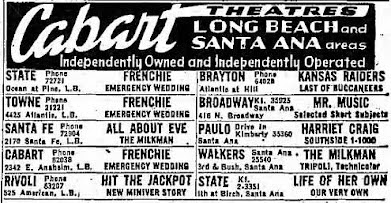


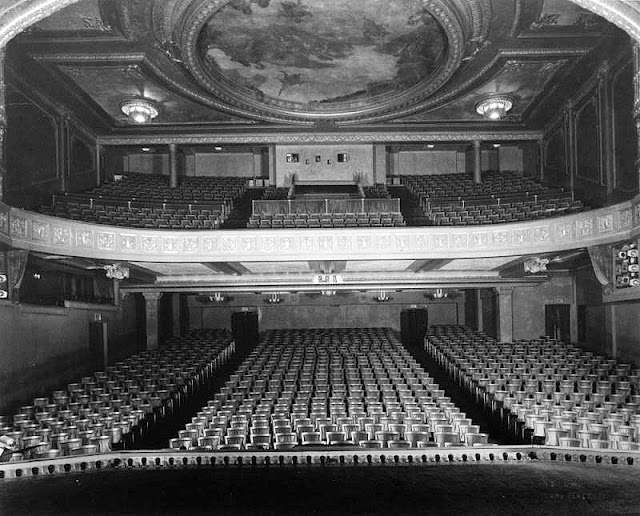
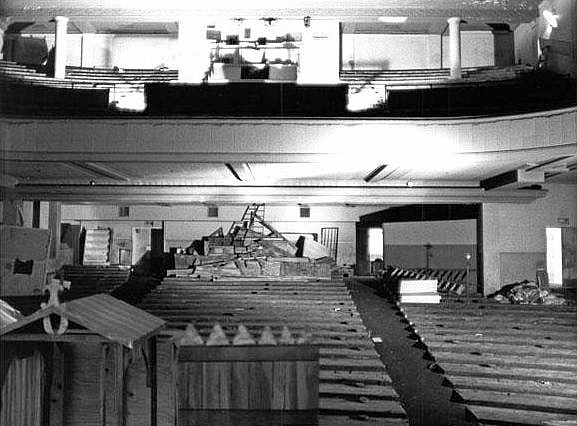




































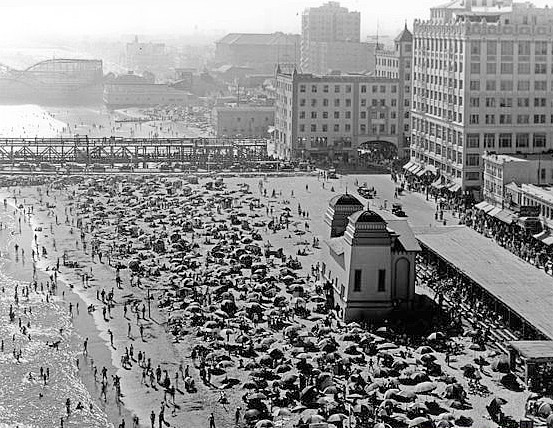





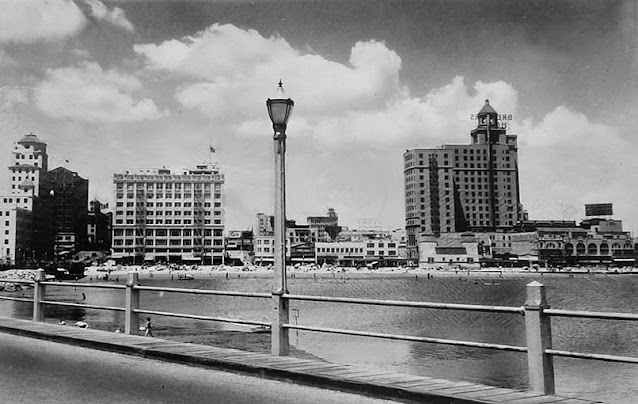










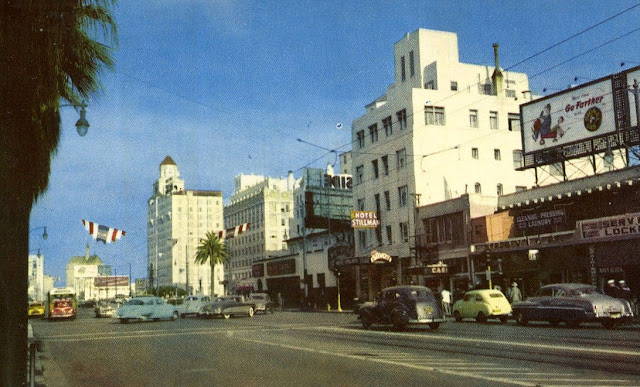



















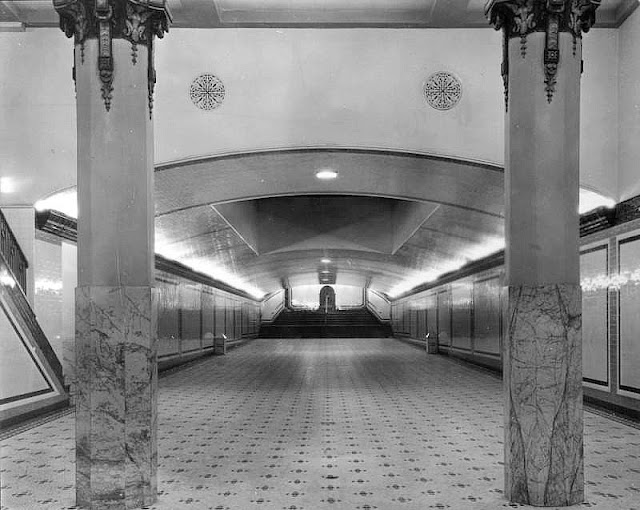
















No comments:
Post a Comment